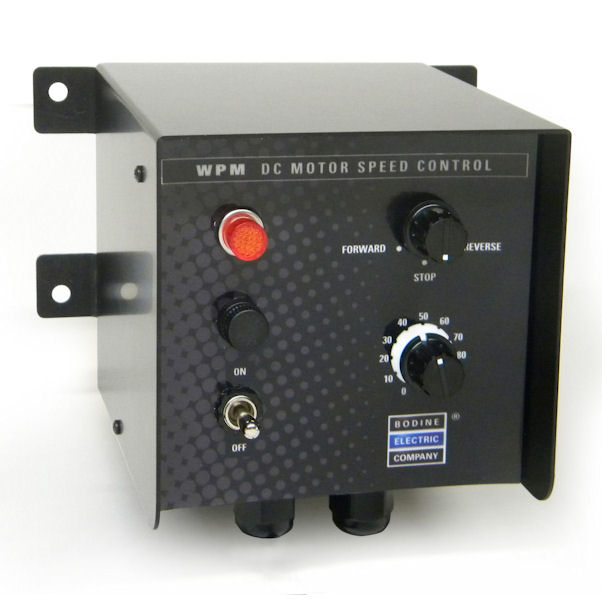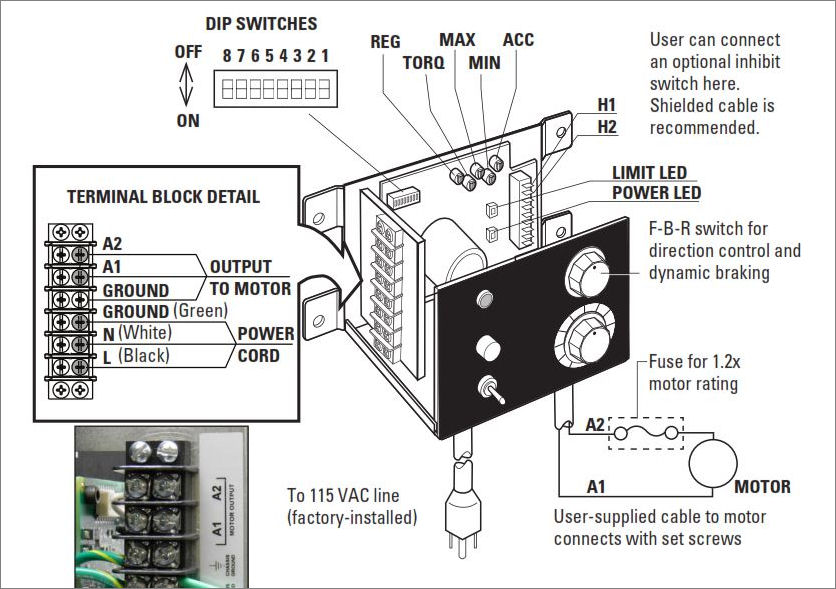Our new stock control, model 0794, features a Forward-Brake-Reverse (FBR) switch for dynamic braking. The new control is ideal for use in bi-directional applications such as conveyors, packaging machines, screen-printing equipment, food processing applications, medical devices, lab instrumentation and labeling equipment.
Housed in a NEMA 1/IP-20 enclosure, the new model 0794 provides smooth speed control for PMDC gearmotors and motors. Its pulse width modulated (PWM) design provides higher torque and lower motor operating temperatures than typical SCR controls. Filtered DC output to the motor allows cooler operation, longer brush life, lower audible noise, and wider speed range. The type “WPM” control accepts 115 VAC, 50/60 Hz, 1-phase input. Motor power ratings are 7/16 HP (326 Watts) at 90 VDC, or 5/8 HP (466 Watts) at 130 VDC.
The Forward-Brake-Reverse switch allows dynamic braking in applications where the motor needs to be manually and infrequently reversed, or when required as a setup function in an application. Five trim pot adjustments (TORQ limit, MIN and MAX speed, acceleration/deceleration, and IR compensation) eliminate the computer-like programming required in other drives. DIP switches allow the control to be easily calibrated for different motor sizes. Two Diagnostic LEDs on the PC board indicate when power is on and when current output is at limit set by the TORQ pot.
Availability: Our new model 0794 is available through Bodine’s extensive distributor network, via direct sales to OEMs, or from the Bodine web site. Stock orders typically ship within 2-3 business days. To learn more about our new model 0794, click here.
What is Dynamic Braking?
In basic (non-servo) drive applications, motors and gearmotors are expected to coast only a few shaft rotations after being de-energized. If the application requires precise braking, electromechanical brakes and clutches should be used (see The Bodine Handbook, chapter 10, p.7). In less critical applications, dynamic braking techniques can be employed. Dynamic braking is achieved by altering the connections to the motor with or without the aid of an auxiliary power source, depending on the motor type (DC or AC). In either case, the motor acts like a generator and the kinetic energy of the motor and the driven load is used to exert a retarding force to slow the forward rotation of the motor.
Permanent Magnet DC (PMDC) Motors: Various techniques are used to accomplish dynamic braking in fractional horsepower PMDC motors and gearmotors. One benefit of the permanent magnet (PMDC) motor over a shunt wound DC motor is that in case of a power failure, the PMDC motor’s braking capability is not affected, because its magnetic field (a permanent magnet rather than a coil) is maintained during a power outage. A normally closed relay or similar device across the armature will automatically function in case of a power failure, shorting the armature’s terminals and initiating the braking action. This inherent characteristic is beneficial, for example, in unwind/rewind applications to prevent unwanted spillage of tape or wire.
The nature of the load is often a vital factor in dynamic braking applications. Caution must be exercised in applying motors which are to be dynamically braked or plugged. In such applications, high currents and dynamic mechanical forces are generated during the braking period. For safety reasons, the thermal and structural capabilities of the drive system should not be exceeded. Dynamic braking of high inertia type loads require additional consideration because of the mechanical and thermal strains which can be induced in both the motor and other associated torque transmitting components. While temperature rise is important in the normal operation of a motor, it is even more important in the dynamic braking of the motor. Since the braking torques generated with some schemes are higher than normal running torque, the energy which the motor must dissipate rises correspondingly. Brush life can be expected to decrease when the frequency or duration of dynamic braking is substantial. Special brushes are usually required.
Model 0794: When the FBR switch on model 0794 is set to “stop” (dynamic braking), the armature leads are disconnected from the control and a braking resistor is connected across the armature terminals causing the motor to decelerate. The response time, or time to dynamically brake, is dependent upon the inertia of the armature, the inertia of the load, brake resistor value, initial speed and a number of other factors. The dynamic braking feature can help to improve cycle times, machine set-up time, and overall process efficiency.
Copyright Bodine Electric Company © 02/2014. All rights reserved.

